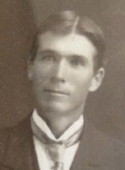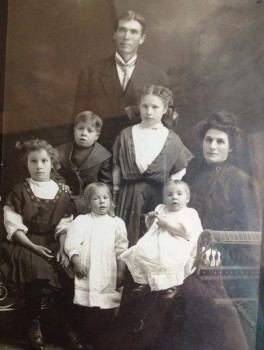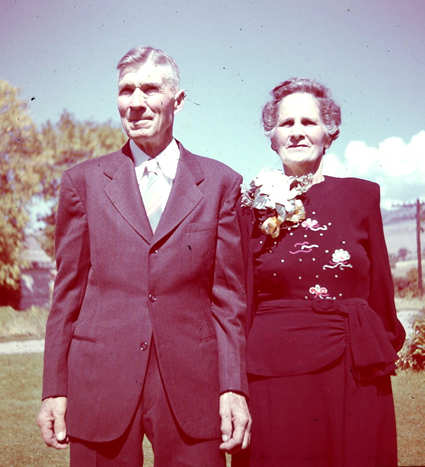|
Journals: Robert Clarkson Ruth Clarkson Ozro Crockett Mary Crockett Websites:
|
George Francis Comish (1873-1955)
Likely written by Marian C. Brereton (granddaughter)
 George Francis Comish was born at Franklin, Idaho May 4, 1873. He was the son of Robert Nephi Comish and Emma Jane Howland. In 1875 he moved with his parents to Cove, Utah, about three miles from Franklin.
George Francis Comish was born at Franklin, Idaho May 4, 1873. He was the son of Robert Nephi Comish and Emma Jane Howland. In 1875 he moved with his parents to Cove, Utah, about three miles from Franklin.
When George was a boy, he used to ride horses in races. Once, when his father told him to ride the horses into town they ran away from him and he had to head them into a telegraph pole to stop them. He felt very bad but his father did not scold him. George worked on his father's farm and each spring left school to help with this work. When George was only six years old he plowed with an ox-team. He drove the team without lines. If he wanted them to go left he wold shout "gee jerry" or to the left "woah-hab buck". He used the first rake machine that came into the valley. He drove this machine at the age of 7. When George was 9 his father died and each child was responsible for certain work under their mother's supervision. They raised all their own food. They kept about a dozen bee hives. When the honey sugared the children would chip off a hunk to eat as candy. They also raised their own sugar cane. The boys killed and cured meat. The women churned butter, made cheese, canned fruits and vegetables. They raised chickens, ducks and guinea hens. They also kept a herd of cows.
George attend grade school in a building that never was warm in winter. They didn't have overshoes and sat all day with damp cold feet. There were 50 pupils in the 8 grades in one room. The teacher often spanked hands with a rules. In 1888, George worked on an irrigation ditch at Soda Springs, Idaho. In 1893, he went to Logan to school. In 1894 he took a place in Marsh Valley, which he farmed.
One day George saw a pretty girl riding in a buggy with another boy. George admired her and got up on the buggy and managed to see her home. The girl was Margaret Biggs. However, he had first seen her when she was 7 and they had attended the same school for several years. George wrote "The first night I took Margaret home, I gave her a goodnight kiss and she returned it with two." They were married in 1897 in the Endowment House. Margaret was 18 and George was 25.
In 1898, George was ordained a Seventy by Apostle Francis M. Lyman and sent on a Mission to the Southern States. His little baby, Reata, was only 2 months old at this time. George wrote of his mission, "We traveled without purse or script, many times were were refused lodging and slept in the woods, with the stars over us and a suitcase for a pillow. We well knew what it meant to be hungry. This always seemed a humbling experience and encouraged us to pray more often for guidance." George spent two years in Georgia, returning December 23, 1900. He splurged and purchased a new suit in St. Louis. "I got off the train in Salt Lake City feeling like a "dandy". Margaret and little Reata were there to meet me. It took a long time before Reata would call me Daddy. My wife was dressed so stylish. She was so amused and often teased me about the Prince Albert suit, which was completely out of style in the west. A new months later I gave the suit to a Southerner. He didn't seem to appreciate it either."
 In 1907, George built a house in Cove, Utah. He was elected one of the first trustees of Mountain Home School District. George raised horses and cattle. He had one of the best teams in the county and always loved good horses. He once sold a good horse for enough to buy a new automobile. One time he had a prize winning driving team. He worked on the thrashing machine for a number of years. Once the machine caught fire and was completely burned. There wasn't any coal so wood had to be chopped to heat the house and cook with. There was always a huge pile of wood under the old shade trees. The chore for the small children was to keep the wood box filled. George gathered timber for fencing, stables, etc. from 10 different canyons.
In 1907, George built a house in Cove, Utah. He was elected one of the first trustees of Mountain Home School District. George raised horses and cattle. He had one of the best teams in the county and always loved good horses. He once sold a good horse for enough to buy a new automobile. One time he had a prize winning driving team. He worked on the thrashing machine for a number of years. Once the machine caught fire and was completely burned. There wasn't any coal so wood had to be chopped to heat the house and cook with. There was always a huge pile of wood under the old shade trees. The chore for the small children was to keep the wood box filled. George gathered timber for fencing, stables, etc. from 10 different canyons.
George was active in Church work and was in the Mutual Presidency at Cove and the first Superintendent in the Sunday School. He was Chairman of the Boy Scouts. The stake had a silk flag they passed each month to the Ward that had the most punctual attendance. George's Sunday School held it for a year when George was Superintendent. (There were 70 students in Sunday School).
In a small community there is never enough money for the building and up keep of country roads. George donated weeks of work for roads. He was supervisor of Mountain Home Roads.
About 1909, George was called on a mission to the Southern states. He sold cattle and borrowed money. When he went to the bank to borrow money the banker who wasn't even a Mormon said, "Your good name entitles you to all the money you need and if your family needs more they can get it." He got as far as Salt Lake, where because of poor health, was not allowed to go. He contributed $50 to another missionary. He bought a place in Franklin upon which he built another house. He was lucky in being able to purchase the very lot his parents had built their first home on and where he was born. George paid $250 on the lot his parents had bought for two oxen.
At this time he was a trustee while the new school house was being built. George was in the Bishopric. He was active for many years in the Idaho Pioneer Day celebrations, an Idaho state holiday. Each year a program was prepared for the first pioneers that came to Franklin. It was George's duty to look after banquets. 250 attended. He was also chairman--selling concessions to parties. George was one of the Pioneer Govenors and took a great interest in this celebration.
George frequently attended General Conference in Salt lake, and sat with the High Priests in the reserved section He was ordained a High Priest by W.M. Skidmore, October 24, 1929.
George liked to go places and made trips to Boulder, Colorado and Calif. and Salt lake to see his daughters Della, Reata and Geneve. In 1943 he sold his Cove farm to his sons Clair and Burdett. In 1950, after a long and suffering illness, his wife, Margaret, died. George was very lonely, and five years later he died (of pneomonia. He and his wife are buried in Franklin, Idaho.
Here is picture of George and Margaret:

| If you see any problems with this website, feel free to contact our Webmaster. |